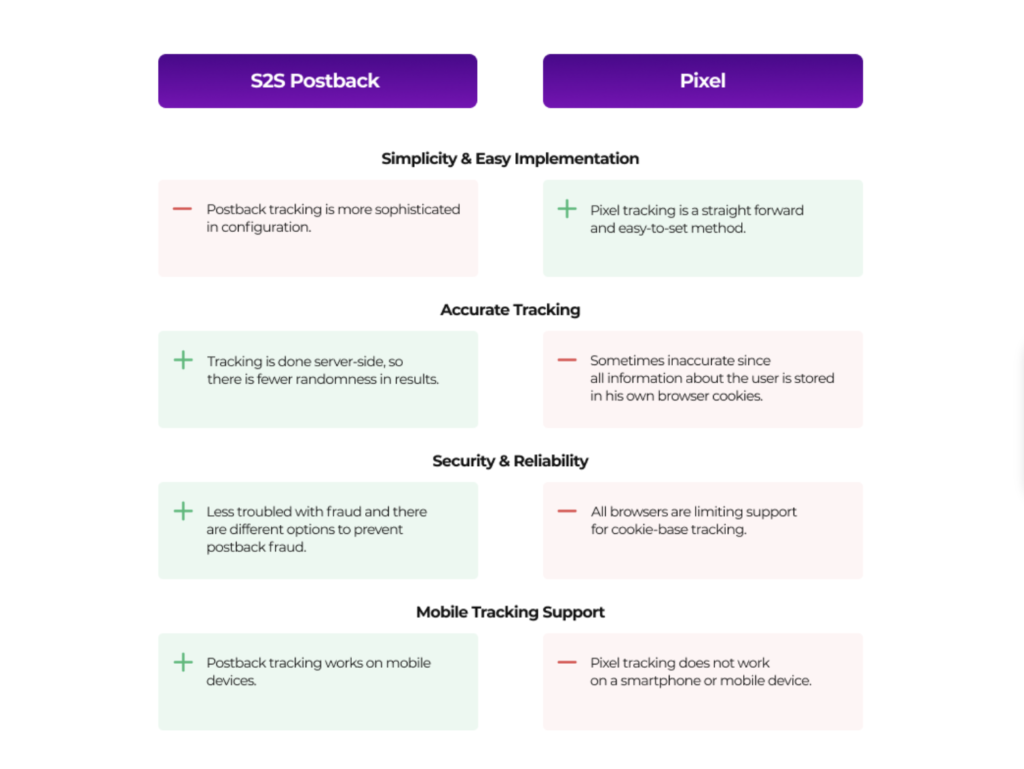Just started at affiliate marketing and wondering which affiliate tracking method to go for? Marketers are often stuck between choosing pixel tracking or postback tracking when it comes to performance marketing.
These two major tracking methods are most commonly used among marketers, and because of their features, sometimes, it’s hard to determine which is better between the two. If you and your advertiser are still stuck between choosing between pixels and the postback tracking method, here is a complete difference that can help you make a better decision.
Why Do You Need an Affiliate Tracking Method?
Affiliate tracking method, be it pixel, postback, or cookie-based tracking, captures the customer page views, clicks, and conversion data that affiliates provide to a brand. Using this data, a tracking solution can generate reports to help brands understand the effectiveness of their affiliate marketing program.
Different Types of Affiliate Tracking Methods
The methods of affiliate tracking will depend upon the tracking solution you’re using and the type of campaign you’re running. There are several popular affiliate tracking methods as given below:
- Postback
- Pixel
- API
- App SDK
- Web SDK
- SKAD Networks
Let’s discuss the process and purpose of each one in detail.
Pixel Tracking Method
This tracking method is browser-based that is also known as the client-side tracking method. The browser plays a major role when it comes to tracking conversions by simply placing a cookie in authenticating the session and attributing it to the appropriate affiliates afterward.
It also known as client-base, cookie-based, or in-browser tracking, is reasonably the most common method because of its simplicity.
The main reason the Pixel tracking method uses cookies is that it can store the session value in the cookie in tracking conversions and have this information in the browser in just a few minutes.
How Does Pixel Tracking Method Work?
The tracking pixel allows us to track how many times a webpage has been viewed (visits) or how many times an email was opened (opens). A tracking pixel is a little piece of code containing an image (1 pixel x 1 pixel dimension) that should be inserted in the pages of your website or in the email you send.
Pros & Cons of Pixel Tracking Method
Pros
- Amongst all, Pixel Tracking Method is the most convenient since you don’t require technical resources to implement it. It’s easy to deploy and use.
- It allows you to capture various client-side events, such as page views, button clicks, form submissions, etc. useful when the campaign needs to track multiple goals.
- Pixel tracking can provide near real-time data as it operates directly within the user’s browser. It can be used across various platforms, including websites, emails, and ad campaigns.
However, there are limitations to this type of affiliate tracking method.
Cons
- The conversion will not be attributed in case it takes place on a mobile device or a web browser that doesn’t allow cookies, like Safari and Firefox.
- Also, some users may have ad-blocking software that prevents pixel tracking, leading to incomplete or inaccurate data.
- Additionally, there are concerns about its accuracy since it relies on client-side execution, which can be tampered with or manipulated by users, affecting data accuracy.
Postback Tracking Method
Now let’s proceed to the postback tracking method that doesn’t involve cookies, which is why it is also known as the cookieless tracking method. It is called Call Back or S2S(Server 2 Server).
You are not also required to modify the confirmation pages in the process. As soon as a conversion occurs, the advertiser will automatically fire a postback using the affiliate ID.
Usually, Postback URL is also referred to as:
- Callback tracking
- Server-to-server (S2S) tracking
- Cookie-less conversion tracking
How Does Postback (or S2S) Affiliate Tracking Work?
Compared to Pixel Tracking, Postback is a bit complicated. It is explained in the most simplified manner below:
- After users see an ad and click on it, their identification data is sent to the management platform server that generates and assigns a click ID to the conversion.
- Then the click with the assigned ID goes to the affiliate network and/or the advertiser, so they receive all data on users’ sessions.
- This whole chain process takes place in a matter of seconds, without affecting users. Thus, after clicking on an ad, a user gets to the landing page without any delay.
Why Postback?
- It allows affiliate marketers to track and attribute conversions to their affiliate marketing campaigns.
- S2S postback is the best and most accurate way of counting conversions.
- This can be done without the need for a tracking pixel on the merchant’s “thank you page”.
- It does not rely on cookies, which can be blocked by browsers such as Firefox or Safari.
- They give affiliates the power to attribute conversions to their campaigns in an instant.
- There is a lesser probability of fraudulent conversions in the case of postback tracking.
Pixel vs. Postback: Which Affiliate Tracking Method is Better For You?
If you’re wondering which Affiliate Tracking Method works best for you – here’s a quick fact –
In 2024, Google is planning to migrate 1% of Chrome users to Privacy Sandbox and disable third-party cookies for them. This comes as a part of its plan to completely phase out third-party cookies from the second half of 2024.
This answers the question – Which affiliate tracking method is better among Pixel vs. Postback?
However, that’s not all. There are other reasons why the Postback or S2S tracking method is one of the most preferred conversion tracking methods by marketers. It is explained in a simplified manner in the infographic below.
API(Application Programming Interface) for Affiliate Tracking Method
In simple words, API which stands for Application Programming Interface, is a set of tools and protocols that together builds a software application. It allows businesses to access data from other sources and create automated processes to help them streamline their business processes.
However, APIs find a different kind of application in the affiliate marketing industry. It is one of the affiliate tracking methods, that allows advertisers to track sales, clicks, impressions, and other conversions in real-time
There are a number of APIs available for affiliate marketers including Google Analytics, Facebook Ads, Commission Junction, Postman, etc.
To integrate an API from your Trackier Performance Marketing Software or iGaming platform, you need to generate an API key on the platform.
The picture below shows how to generate an API Key in Trackier’s Platform.
Why Use API for Affiliate Tracking Method?
- APIs can be deployed to automate processes like setting up commission payments, creating reports, tracking conversions, etc.
- APIs provide more accurate and real-time insights into campaign performance.
- With APIs, both sides of the business have access to real-time performance data, which increases transparency between both parties.
App SDK for Affiliate Tracking
SDK stands for “Software Development Kit”. By integrating a mobile SDK, developers can access tools like analytics or re-engagement, or connect to ad networks to run in-app ads. Trackier allows you to integrate SDK easily and without hassle using the SDK key.
How to Integrate SDK on the Trackier Platform
- There is a unique key generated when you enter the details of your application which you can then use and place in your application to record the in-app events.
- In case, you don’t have a very good knowledge of setting up this you will also find a step-by-step guide and documentation for Android, iOS, Unity, and React native which you will find inside the SDK integration segment of your account.
Web SDK Affiliate for Affiliate Tracking
WebSDK refers to tracking user behavior and data on a website using a Software Development Kit (SDK). Just like the pixel tracking, it uses a snippet of code in the website. However, unlike pixel tracking, it uses first-party cookies instead of third-party cookies.
This method of Affiliate Tracking is still better since it doesn’t use third-party for tracking conversions. Please note that, websites don’t restrict first-party cookies in the similar way they restrict third-party cookies.
This is a simplified and more refined version of cookie-less tracking, which is a web SDK for which you can easily generate code from the panel with just some simple steps.
With this method, you can add pixels in the form of postback directly on the code. This will help you track more accurately when some browser doesn’t support third-party cookies without any restrictions and limitations.
SKAdNetwork
SKAdNetwork was the novel approach by Apple to measure campaigns without invading users’ privacy. According to this development, iOS developers will have to seek users’ permission before sharing their IDFA with third-party partners.
When a user installs an app after engaging with an ad, SKAdNetwork assigns a unique identifier to that install and sends it to the advertiser.
The advertiser then uses this information to measure the performance of their ad campaigns, such as the number of installs and conversions generated, without knowing the specific user’s identity.
SKAD is similar to SDK except SKAD works only on iOS devices.
Limitations of SKAdNetwork
- Advertisers are provided with a lesser amount of data and information while evaluating their ad campaigns.
- Publisher ID will work in the range of 1-100 per campaign or APP ID
- Postback will be fired once in 24 hours.
- No click id is associated with the process
- You can’t send or receive any extra information.
- View-through attribution is not supported.
- Audience Building would be hard.
- Compatibility issues as its complete implementation depend on the developers, who would integrate SkAdnetwork in their applications. If it is not compatible with the app it might have data accuracy issues.
Conclusion
Pixel Vs Postback has always remained a hot topic to discuss. However, finding out the difference between pixel and postback is still a job to done..However, picking one isn’t. Hope you have read this blog to find out how this can help.





